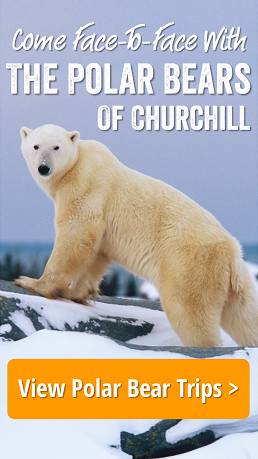by Steve Selden | Feb 7, 2017 | Churchill News
In a time when the Canadian Arctic is the focus of energy and trade route exploration, there are human cultural issues that need to be part of the picture as well. Maatalii Okalik, is a young advocate for the ever expanding Inuit youth population and her passion is ensuring all young people of the north will be able to live to the same standards as other Canadians. The 27 – year old is president of Canada’s National Youth Council and her mantra is just that,;“to ensure that Inuit live the same quality of life as fellow Canadians.”
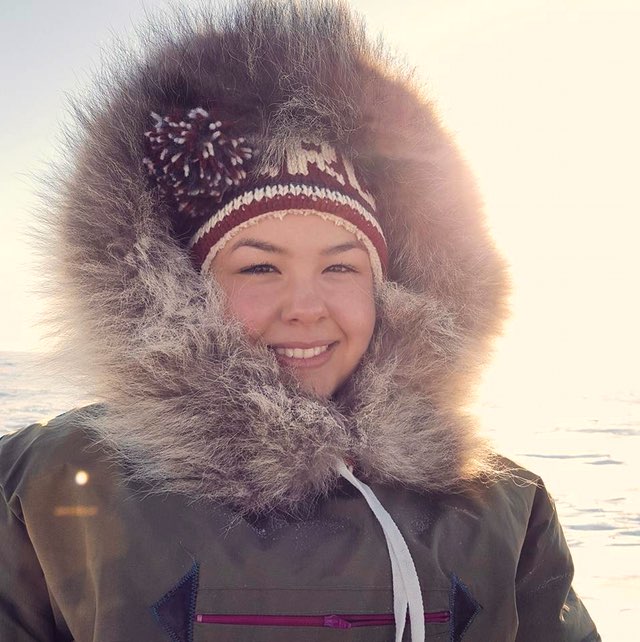
Maatalii Okalik Pres Natl Inuit Youth Council. Maatalii Okalik photo.
Okalik knows the road to Inuit health and education equality will be long and winding and will require hurdling deep – rooted social issues frozen in Canada’s colonial history. Okalik fervently believes that the federal government needs to be more active in revitalizing cultural practices, preserving and facilitating native languages, preventing suicides and upgrading and possibly subsidizing some infrastructure problems.
In Okalik, it appears the Inuit young population will have an inspired advocate for years to come. She was recently bestowed the honor of Indspire Laureate, given to Canadian indigenous professionals and young people demonstrating exceptional achievements in their chosen career. Additionally, Okalik was rewarded with the Qulliit Nunavut Status of Women Council’s Outstanding Young Woman Award!
Arctic Deeply, a northern publication recently interviewed Okalik and she conveyed some pretty informative and interesting thoughts on life in northern Inuit communities. Describing the most pressing concerns and issues of Inuit youth Okalik outlined a basic long – term action plan.
Foremost is the Inuit language -Inuktitut- not being allowed in residential schools. English has been forced upon students therefore degrading the native language of the Inuit people. Okalik contends that federal government in Ottawa should actively push to ensure that Inuit youth should be able to access crucial learning materials in their native language. This would set a basis for equitable education for all Canadians. When the Inuktitut language is watered down the culture will slowly be lost when exposed to the rest of the world.
Secondly, Inuit culture and customs have been identified as an identity crisis currently for Inuit youth. As the youngest, fastest growing population in Canada, Inuit youth are finding cultural practices hard to keep up with. School and work and raising young families impose time and cross – cultural constraints on the continuation of age – old Inuit culture. Youth programming has been seen and proposed as a solution. tradition and modernity need to be woven together more smoothly so to ease the differences between the two.
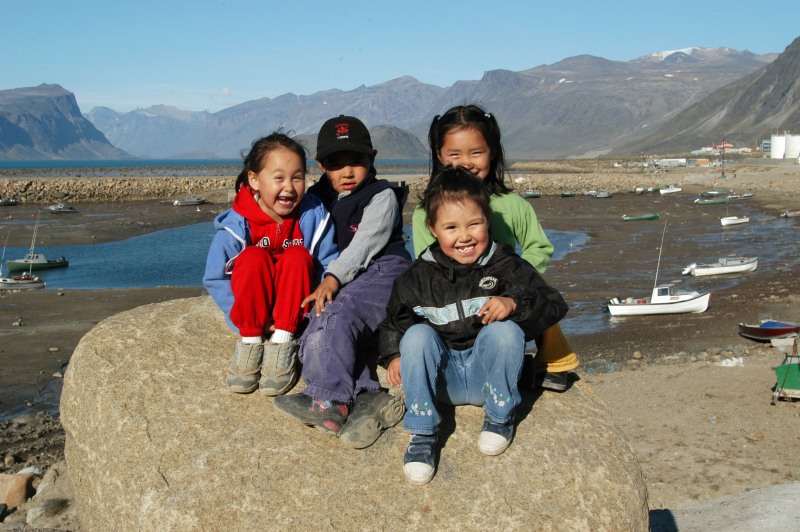
Inuit children in Pangirtung, Nunavut. Robert Galbraith photo.
The third, and most pressing issue, is suicide prevention in the north within the Inuit population. Inuit suicide rate ranks highest within Canada as well as internationally per capita. Okalik and her colleagues contributed to the national Inuit suicide prevention strategy identifying suicide historical tendencies and plans to control them in Inuit communities.
In all these issues it’s crucial to have Canadians as a whole understand the vast gap in social services whether it be housing, food insecurity, cultural access for youth, education or access to quality and equal health care. With Inuit communities existing on the lower end of the spectrum here, there needs to be help assimilating the people to a better way of life being exposed to them from outside. “To me it just doesn’t make sense for Inuit in our particular communities to be living in Third-World conditions. There should be a priority of Canada to address that inequity. It would be a proactive measure that would prevent some of the dire statistics, including our suicide rates.” states Okalik.
Okalik feels her dreams and definitive career moment will be when all Canadians, including Inuit, enjoy the same quality of life. “I think I’m happiest when I see understanding in someone’s eyes – whether that’s an Inuk youth who learned about the history of colonization, or a federal bureaucrat or high-level minister who decides that this should be a priority and it’s a basic human right.” Then that person might be motivated to try and solve the dilemma and possibly influence policy decisions that might impact Inuit in a favorable manner.
Okalik’s near – term hopes are for the federal government to follow through with the Truth and Reconciliation Commission’s call to action #66 restoring power to indigenous communities all across Canada including most urgently Inuit communities in the Arctic. “The other thing that I think that I’d like to see is the telecommunication of the Canadian Arctic to be at par with southern Canada, including internet and phone. We recognize that these are essential services. It’s not at par in the Arctic. That influences education. It’s really important. Especially when, across the Arctic, we don’t have hospitals in all of the communities. Telehealth for example, is something that’s being explored. We should have access all across the board. As well as internet.”
Lastly Okalik believes that air services across the Nunavut settlements need to become more essential since there are no roads to communities. Many of the social inequities pointed to here are critically impacted by this transportation mode.
by Steve Selden | Feb 6, 2017 | Churchill Photography
These boreal forest images with the glow of the receding sun in the background gives an aura and feel only the Arctic can provide. Trees in the north define the landscape in such a way we only can understand by experiencing the north firsthand. The cold air and snow on the ground and trees gives the eyes and mind a different perspective that the photos transcend. Churchill photographer Alex De Vries – Magnifico has refined his style to capture that distinct Arctic feel by continually searching for those subtle details of the region that make it unique in the world.

Snow covered boreal forest in Churchill. Alex De Vries – Magnifico photo.

A krumholz “flag tree” in Churchill. Alex De Vries Magnifico photo.

Magnificent boreal forest with snowy covering. Alex De Vries – Magnifico.

Snowy boreal forest outside of Churchill. Alex De Vries – Magnifico photo.
by Steve Selden | Jan 23, 2017 | Tour News
Before northern lights season starts we wanted to post this blog series from Kathy and Jeff Klofft from Boston. The couple joined Natural Habitat Adventures last fall on a polar bear trip to Churchill and documented the trip in a blog by Kathy and some awesome photos from Jeff. Their blog site is Go See It Travel documenting their adventures around the USA and world. These next few days we will publish their account of Churchill as well as lots of photos from the experience! Enjoy.
Polar Bears of Churchill, Manitoba, Canada
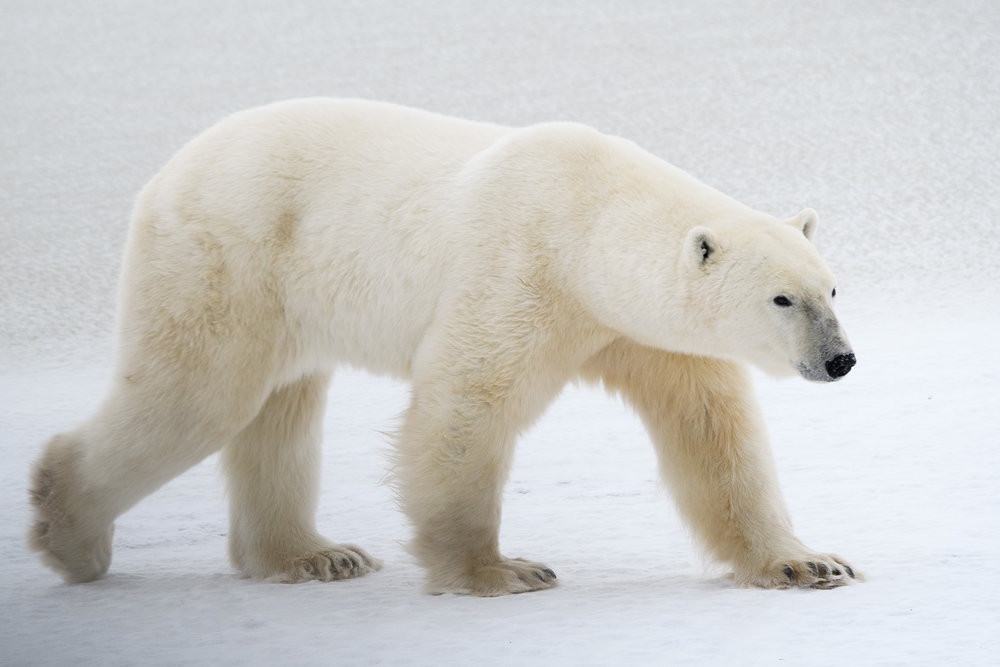
Polar bear on the Churchill tundra. Jeff Klofft photo.
There are only a few places in the world to see polar bears in the wild. This opportunity is further restricted by the fact that generally solitary polar bears have a huge territory range for most of the year and most live year round out on polar ice that is virtually inaccessible to human beings. The bears eat primarily seals, hauling them out of their breathing holes in the ice with their enormous paws. Some of the bears living furthest south, such as the population near Churchill have to move to land for a few months when the ice melts each summer. One place where polar bears can be seen is in Churchill Manitoba in the Wapusk National Park in Manitoba, Canada. The park area was created on the shores of Hudson Bay, where polar bears wait for the ice in Hudson Bay to freeze each fall. The bears don’t eat during the summer, spreading out in Northern Canada or denning up to give birth to cubs, and are just waiting for the ice to form again, so they can go back out hunting.
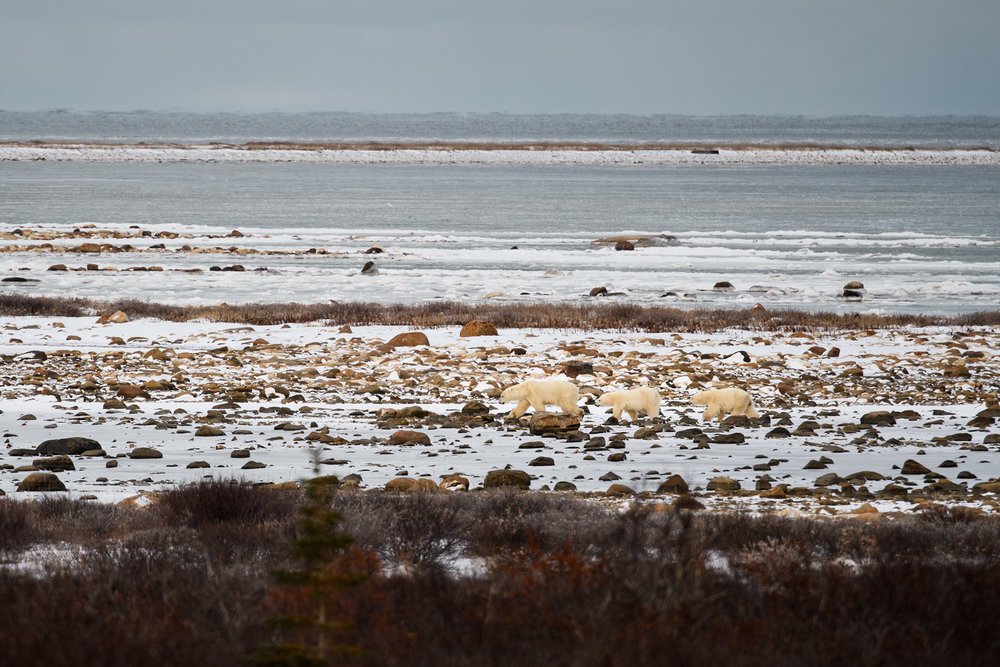
A mother and her cubs wait for the ice to freeze on Hudson Bay to begin hunting seals. Jeff Kloft photo.
With a helicopter (like the researchers use) or lots of time living in bear country, a human might have an encounter with a bear during the 8 months, or so of the year that the bears are on ice, but most chances for bear and human encounters in Churchill will be in the late fall, mid October to mid November, when the bears start to literally lie on the shores waiting for the ice to from. Watching the bears on the shore waiting reminded me of this adaptation of a phrase about boiling water…”a watched bay never freezes!” But their month long wait on the shores of the Hudson Bay also provides a chance for human/bear encounters.
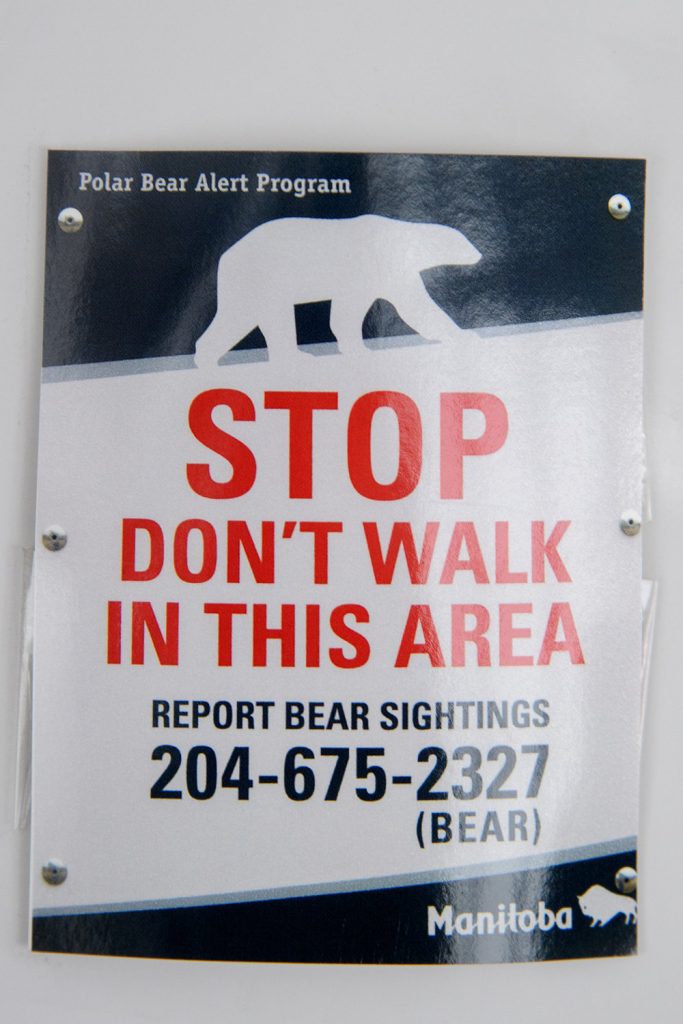
Polar bear warning sign in Churchill. Jeff Klofft photo.
For most of human history, polar bear/human encounters consisted of bears being hunted by Inuit people who used every part of the bear for survival, or dangerous encounters where bears sought human food or sled dogs and had to be destroyed to protect people and property. We learned from our guides that governments who operate in polar bear range states joined together to make agreements which would allow traditional hunting for people who rely on polar bears for survival, but protect them commercial hunting, which was decimating the numbers of polar bears in the wild. Since then, efforts were made to ensure bear/human conflicts could be avoided. Polar bear tourism was developed to happen only in the safest ways for both humans and bears. During our trip we heard from Elizabeth Kruger, World Wildlife Federation Arctic and Bering Sea Program Officer, that local residents have been empowered and trained to use bear patrols to redirect bears from populated areas, and local activists have changed garbage handling methods to discourage them from seeking human food. Our polar rover driver described that growing up in Churchill, the family would go out to the dump to see bears. Today, creative handling and containment of garbage have eliminated the bears at the dump and they roam where they belong, in the tundra. In Canada concessions were given to allow operators to allow polar bear tourism in the safest possible way.
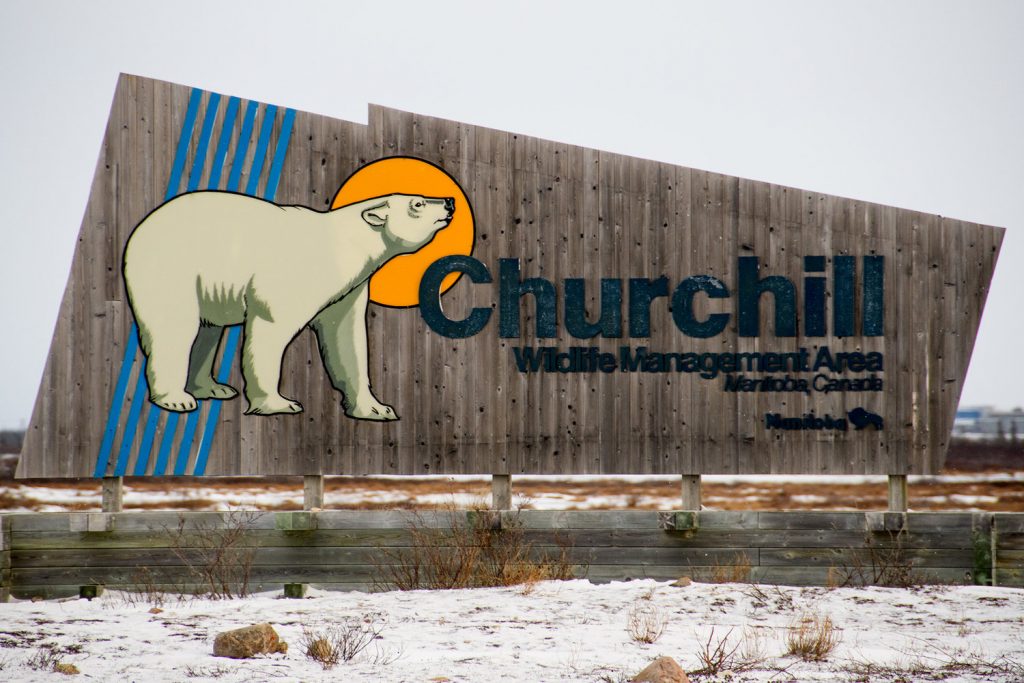
Welcome to Churchill sign on the outskirts of town. Jeff Klofft photo.
So…bears are being conserved, but there are only a few weeks a year in Churchill when it’s practical to see polar bears, and the location to find them is still very remote…so how do you “go see it”?!
Tomorrow we will post more of the blog and answer the question above.
by Steve Selden | Dec 21, 2016 | Churchill News
Outgoing President Barack Obama executed a critical order on Tuesday by banning any new gas and oil drilling in federal waters in Arctic and Atlantic Oceans. The move comes as an environmental safeguard prior to the new Republican administration taking office January 20th lead by President elect Donald Trump.
Utilizing a 1950s-era law termed the Outer Continental Shelf Act, Obama used the power of President to limit areas from mineral leasing and drilling. Trump’s incoming administration will only be able to challenge and change the edict by fighting it in court according to several environmental groups agreeing with the order.

Map of the Arctic waters to the north of Alaska just protected by President Obama. BOEM image.
The Alaskan waters ban affects 115 million acres in the Chukchi Sea and most of the Beaufort Sea as well as 3.8 million acres in the Atlantic Ocean. A main concern of environmental advocates regarding fuel exploration in the region is the devastating affects an oil spill or gas leakage in the oceans would have on the ecosystems. Such a remote and harsh climate would severely limit the capabilities of clean-up crews and emergency response teams. Wildlife such as polar bears, whales, seals and fish would be harmed and populations of the animals could be irreversibly destroyed.
Trump has continually stated that he will seek to expand offshore oil and gas drilling in the waters north of Alaska. Recent releases from his energy transition team predicted increases in production in the Chukchi and Beaufort Seas. These forecasts have been dealt a serious blow and are likely “dead in the water” at this time. Trump spokespeople would not comment on the actions.
Very limited oil and gas exploration has been happening in recent years as less expensive shale oil production primarily out of Texas and North Dakota has been the priority. Drilling off Arctic shores in Alaska is more expensive and risky in nature. Most notably, Shell Oil pulled out of the waters just last year following a shipping accident and limitation laws discovered by environmental groups limiting exploration.
Proponents for drilling such as the American Petroleum Institute, an oil industry group, stated that Trump would be able to use a presidential memorandum to lift the ban rendering the move by Obama obsolete. “We are hopeful the incoming administration will reverse this decision as the nation continues to need a robust strategy for developing offshore and onshore energy,” said Erik Milito, API’s upstream director.

A view over the now protected Arctic waters from Barrow, Alaska. NASA photo.
Obama and Canadian Prime Minister Justin Trudeau are in agreement with protecting Arctic waters. The two leaders are initiating joint actions and these actions “reflect the scientific assessment that, even with the high safety standards that both our countries have put in place, the risks of an oil spill in this region are significant and our ability to clean up from a spill in the region’s harsh conditions is limited.” stated Obama.
In similar action Trudeau and Canada will designate all Arctic Canadian waters off limits indefinitely to any future offshore Arctic gas and oil licensing. These sanctions will be reviewed every five years through a climate and marine science-based life-cycle assessment. Obama’s action, unlike the five year review applied to the Canadian law, contains no designated analysis period outlined for the U.S. law.
Under current law, authorization is not granted for reversing a previous presidential order of this kind so efforts by Trump to challenge this move will most likely need to be taken up in court via a lawsuit.
“No president has ever tried to undo a permanent withdrawal of an ocean area from leasing eligibility,” said Neil Lawrence, Alaska director and attorney at the Natural Resources Defense Council.
by Steve Selden | Oct 23, 2016 | Tour News
Natural Habitat Adventures guide Brad Josephs and his band of travelers enjoyed an exciting start to the polar bear season with good bear sightings along with some other fantastic wildlife encounters. The group also witnessed an iconic landmark coming to the ground out in the Churchill Wildlife Management Area.
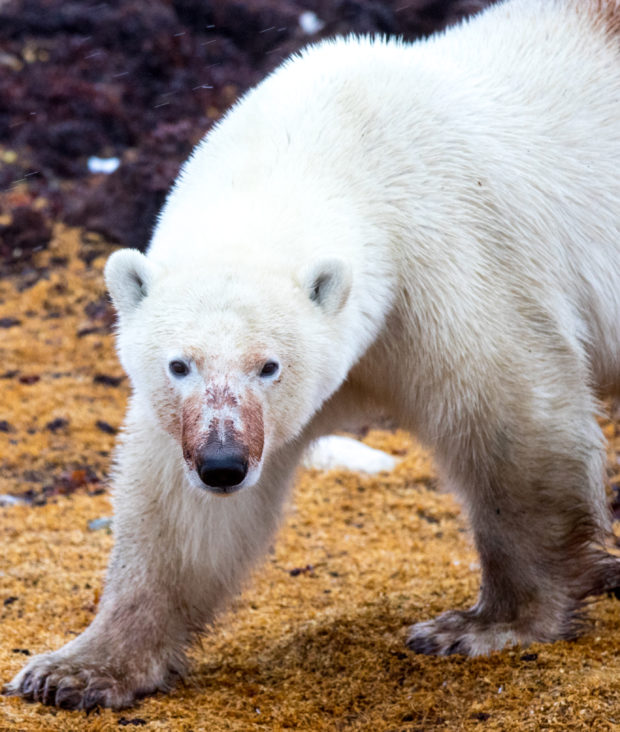
Polar bear with a dirty snout. Brad Josephs photo.
Veteran guide Brad reported warmer than average temperatures for this time of year though that didn’t deter polar bears from revealing themselves on the tundra. A pair of snowy owls perched on Precambrian rocks searching for lemmings or Arctic hares made for prime viewing and photo ops. A small group of willow ptarmigan made their way from the willows, imagine that, into sight of the excited group. A good look at an iconic northern species.
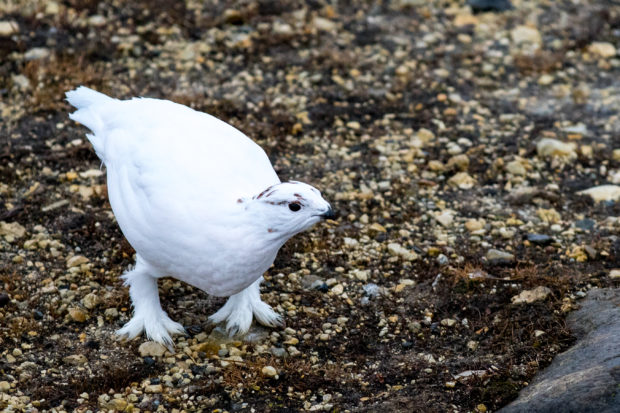
Willow Ptarmigan displaying furry, insulated feet. Brad Josephs photo.
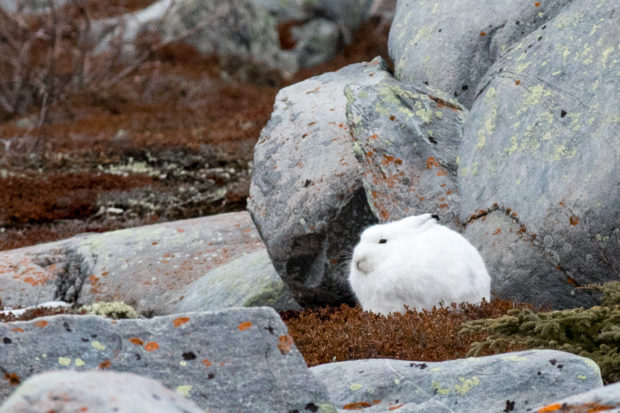
Arctic hare stoic ly waiting for the protection of snow. Brad Josephs photo.
Brad described the falling of an iconic landmark out in the CWMA.; “A strange thing happened while we were on the tundra. We drove by an old military observation tower built in the early 1950’s for cold weather training, and when we drove by it again a few hours later it had collapsed in the high winds.” The landmark was dubbed “first tower” since there were two of these structures built for military training observation in the 1950’s and this one is the first one that polar rovers encounter while searching the tundra for wildlife. It’s quite a ways out on the trail and served as a landmark for rover drivers, especially in snowy conditions. Sad to see it go!

The demise of first tower in the CWMA. Brad Josephs photo.
While exploring the tundra out near the fallen tower, the group had an amazing encounter with a red fox carrying its ptarmigan prey in his mouth. Surprised by being “caught in the act” , the fox paused to take in the curious onlookers gazing at him in wonderment of the laws of nature and the survival chain of life in the Arctic wild. What an exciting start to the 2016 polar bear season in Churchill!
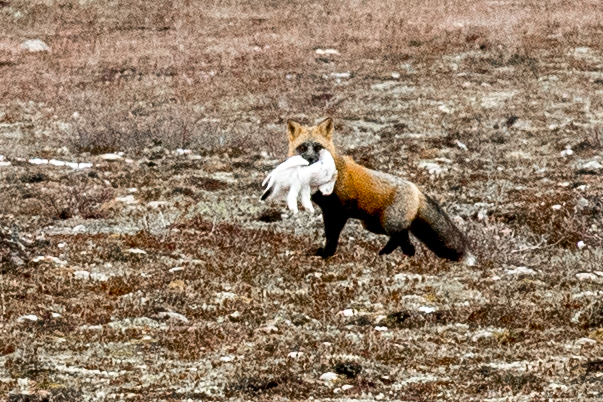
A red fox with a tasty meal of willow ptarmigan. Brad Josephs photo.


















